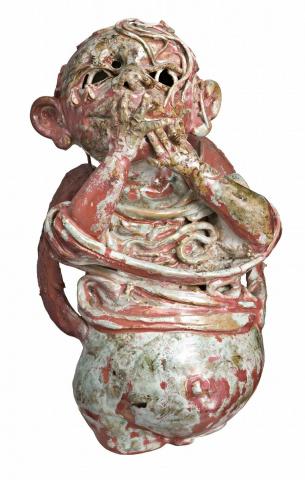ANGEL, c.1958
John Perceval
glazed earthenware
27.5 cm height
Lauraine Diggins Fine Art, Melbourne
Private collection, Melbourne
John Perceval's ceramic Angel sculptures are among his most engaging works. Full of life, human and heavenly foibles, they captivate through their large child-like eyes and antics, crazy moments and endearments. Faces range from the angelic to the demonic - Angel Barry in Heaven, 1957/8, even being based on Perceval's friend Barry Humphries. Bernard Smith described their first exhibition at Melbourne's Museum of Modern Art in 1958 as 'one of the most important one-man shows held in Australia since the war.'1 Followed the next year by Sydney's Terry Clune Galleries, they were immensely popular. Angels were acquired by the leading private collectors, including James Fairfax of Sydney, Kym Bonython of Adelaide, and fellow artist William Dobell. Public galleries responded with equal enthusiasm, fine examples now being in the best Australian collections.
So human and so cheeky, their subjects include angels in ecstasy, clowning, kissing, dancing, fighting, and a special group playing musical instruments - including Angel Playing the Lute in the collection of the University of Melbourne, the celebratory fanfare of Trumpeting Angel, and the Queensland Art Gallery's Angel with a Lute. Bald or of curly or thickly tangled hair, they sing, smile and are often quizzically mischievous. Although of the same style and intent, not all were actually angels - Moses in the Bulrushes, Mother and Child in the collection of the Art Gallery of Western Australia, and Romulus and Remus with Wolf Mother being a few examples. Dwarf and Cripple adopted a more social realist role, yet was so beautiful of form with bright red and green glazes, it took its special place in the Washington Chancellery in the USA. These same glazes are found in the present Angel, the rich red sang-de-boeuf glaze contrasted with an almost celadon green. Intimacy of size, as in this work, also adds to their appeal, as does the lively wit and sparkling play of light across lustrous surfaces. Wheel thrown and built by hand, they have a rococo delight in gaiety and intricacy of line and form. Inspiration came from several sources. Foremost were earlier paintings of his own children, and the old masters Perceval acknowledged - the early Italian Renaissance sculptors Luca della Robbia and Donatello, and the fifteenth century French master Jean Fouquet's painting Virgin and Child with its crowd of red and blue angels.2 But most of all - the Angels are, in fact, John Perceval telling us about himself: he is his own angel - 'a puckish angel, a mischievous angel, a trouble-making angel, an angel who plays the harp with an angelic leer, a perverse angel, a clown angel.'3
1. Smith, B., 'The Antipodeans', Australia To-Day, Melbourne, 14 October 1959, p. 104
2. In the collection of the Royal Museum of Fine Arts, Antwerp
3. Reed, J., 'John Perceval', Art and Australia, Ure Smith, Sydney, vol.5, no.1, June 1967, p. 361
DAVID THOMAS
